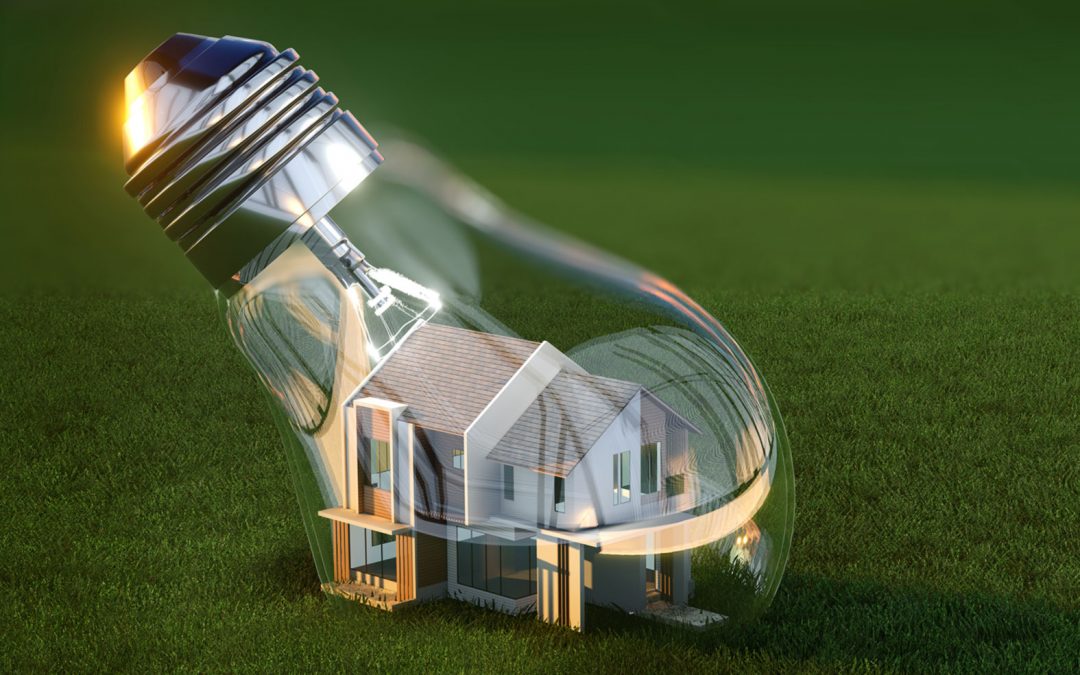Are you considering new home construction? If so, it’s the perfect time to consider the long-term savings that will come along with energy-efficient construction, heating and cooling options, hot water systems, lighting, and appliances. You can save money, conserve energy, and in some cases earn rebates and tax credits through green building incentives.
The U.S. Department of Energy developed a national rating system – the Home Energy Score – which rates a structure for its energy efficiency based on construction, heating, cooling, and hot water systems.
There are many ways to make sure your home is energy efficient, these are just a few you might want to consider when meeting with your custom home builder. At the planning stage for your new home is the best time, as it is easier and more cost-effective to add these features during the construction of your new home than it is to retrofit the home years later.
While it may increase upfront costs, savings made over the lifetime of owning your new home will outweigh the initial investment. In the long run you will be happy having made the decision to build with energy-efficient construction options, appliances, lighting, and renewable energy systems. Additionally, local climate and site conditions should be taken into consideration during the design/planning phase for optimal energy efficiency.
Energy-Efficient Considerations During New Home Construction
Directional Design
Before the slab is poured, it is essential to determine the positioning of your new home on the property for maximum passive solar gain in the winter and to avoid excess heat during the summer months. The orientation of the house is key to maximizing energy output.
Landscaping
Planting deciduous trees on the east and west sides of the home once the trees have matured will provide shade during the summer months, a vital consideration in sunny Florida. When the trees shed their leaves in the fall, they will provide passive heating by the sun during the winter.
Build Tight, Ventilate Right
Air leakage is one of the leading energy wasters in your home. The proper sealing of joints, sills, ducts, doors, and vents are crucial for energy efficiency and can significantly reduce heating and cooling costs. Natural attic ventilation and attic fans are one of the least expensive ways to increase energy efficiency in a home.
Heat Recovery
Heating and cooling accounts for nearly 48 percent of all energy consumption in a household. Through energy-saving technology, a heat recovery chiller allows for year-round cooling and heating as the production of chilled water generates heat.
Heating Design
Although not as big an issue here in Florida as it is for our northern friends, heating costs still comprise a large portion of a home’s energy bill. An efficient heating system including a programmable thermostat and weather compensators are essential during the design phase and can reduce cooling and heating costs as much as 10 percent.
Lighting
Another critical factor for improving your home’s energy efficiency involves lighting options. LED lighting can reduce energy use between 33 and 80 percent.
Tankless Water Technology
Hot water accounts for between 15 and 20 percent of most home’s energy bills. A tankless water technology system eliminates the need for water storage and reduces standing heat loss.
Solar Power
Energy costs are steadily on the rise. The ability to generate your own electricity or supplement your heating and hot water costs by using a solar thermal system pays for itself. Additionally, excess electricity can be sold to the grid or stored as self-generated power.
Insulate
Insulate your home from heat loss with passive and long-lasting construction adjustments by using energy efficient systems and materials. This includes insulated concrete forms, blown-in foam, thick wall construction, and roof insulations. These changes in building materials can save you up to 20 percent on heating and cooling bills.
Topping Things Off
Cool roofs are made of highly reflective materials, reflecting more light and absorbing less heat from the sunlight. This will keep homes cooler when temperatures are on the rise.
Other Things to Consider
Use low-flow faucets and showerheads to save on water bills, clean and change filters regularly, and reduce water heater temperatures to 130 degrees to save energy and money.
Things to Remember
It is easier to design a well-insulated, efficiently lit, correctly orientated, and efficiently heated building than it is to retrofit an existing home for optimal energy-efficiency.
Talk to Passage Island Construction for energy-efficient new home building options as you start planning your new home. We offer multiple energy-saving features to make your new home efficient and more eco-friendly. To learn more about tax breaks for energy-efficient homes contact the state energy office, your local utility, and the building department. Product manufacturers periodically offer discount and rebate programs, so search their sites as well.

